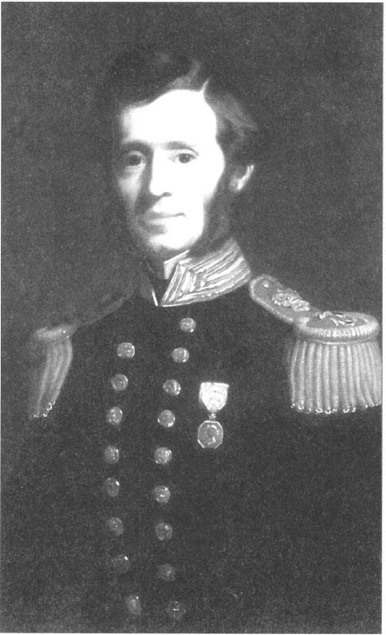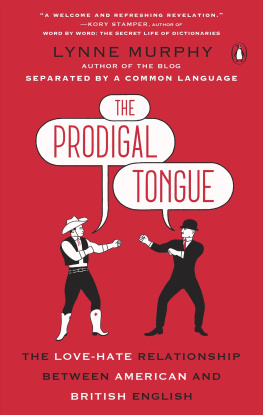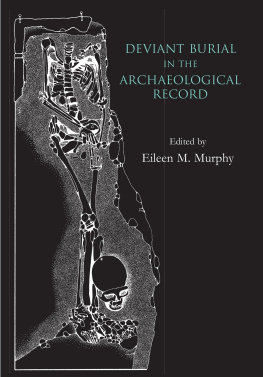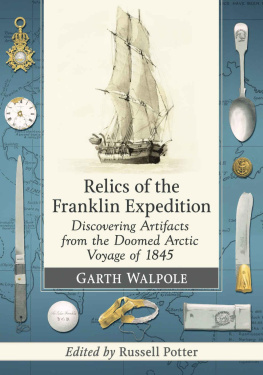The Arctic Fox

The Arctic Fox
Francis Leopold McClintock
David Murphy

THE DUNDURN GROUP
TORONTO
Copyright David Murphy, 2004
Published in Ireland by The Collins Press,
West Link Park, Dougheloyne, Wilton, Cork.
ISBN: 1-903464-58-7
All rights reserved. No part of this publication may be reproduced, stored in a retrieval system, or transmitted in any form or by any means, electronic, mechanical, photocopying, recording, or otherwise (except for brief passages for purposes of review) without the prior permission of Dundurn Press. Permission to photocopy should be requested from Access Copyright.
Library and Archives Canada Cataloguing in Publication
Murphy, David
The Arctic Fox : Francis Leopold McClintock, discoverer of the fate of
Franklin / David Murphy.
Includes bibliographical references.
ISBN 1-55002-523-6
1. McClintock, Francis Leopold, Sir, 18191907. 2. Arctic regions Discovery and exploration British. 3. Explorers Arctic regions Biography. 4. Explorers Great Britain Biography. 5. Admirals Great Britain Biography. I. Title.
| FC3961.1.M33M87 2004 | 917.19041092 | C2004-903712-9 |
1 2 3 4 5 08 07 06 05 04
Design and layout: Dominic Carroll, Co. Cork, Ireland
Cover design: Artmark, Cork, Ireland
Printing: Creative Print and Design (Wales) Ltd
www.dundurn.com
Dundurn Press
8 Market Street, Suite 200
Toronto, Ontario, Canada
M5E 1M6
Dundurn Press
2250 Military Road
Tonawanda NT
U.S.A. 14150
For James McGuire
CONTENTS
LIST OF ILLUSTRATIONS
A NOTE ON TERMINOLOGY
During the period covered in this book, the word Eskimo (or Esquimaux) was in common use. Of the word Eskimo, the Oxford English Dictionary has this to say:
Some people believe that it is better to use the term Inuit rather than Eskimo, because they think that Eskimo could be seen as offensive. The term Eskimo, however, is the only term that correctly covers both the Inuit (people of northern Canada, and parts of Greenland and Alaska) and the Yupik (people of Siberia, the Aleutian Islands and Alaska), and is still widely used.
Oxford English Dictionary (Oxford, 2002)
Given that this book refers only to the inhabitants of Greenland, northern Canada and Alaska, the term Inuit is used in preference to Eskimo in the main body of the text, while the term Eskimo is used only in quoted text.
ACKNOWLEDGEMENTS
A significant number of people gave me advice, encouragement and practical help while writing this book, and they are all deserving of my thanks.
I would like to thank everyone at the Scott Polar Research Institute (SPRI) in Cambridge, many of whom went out of their way to help me during my research visits. Deserving of special mention is Robert Headland, who was always available with his vast knowledge, keen insight and infectious enthusiasm. I would like to thank Caroline Gunn for her help and also for deciphering McClintocks dreadful handwriting on a couple of occasions. I am very grateful to Lucy Martin of SPRIs photographic archive for organising some of the illustrations for this book. It was with extreme regret that I learned early in 2004 of the death of William Mills, librarian and keeper of collections at SPRI. William was always friendly and helpful to those who sought his advice, and I am just one of the many researchers who were assisted by his encyclopaedic knowledge of polar exploration.
I am indebted to the staff of the Royal Irish Academy library who provided both practical assistance and a place of scholarly escape. My special thanks go to Siobhn Fitzpatrick, Petra Schnabel, Dymphna Moore, Patrick Kelly and Karl Vogelsang. The staff of the Early Printed Books Library in Trinity College, Dublin gave me invaluable help yet again, and my thanks go to Charles Benson, Shane Mawe and Rose Reddy.
Since 1997 I have worked with the Royal Irish Academys Dictionary of Irish Biography, and it was through this project that I first became interested in Irish polar explorers in general and McClintock in particular. I owe my colleagues at the Dictionary of Irish Biography a particular debt of gratitude, and wish to thank James Quinn, Richard Hawkins, G.J. Woods, Helen Andrews and Linde Lunny.
The National Museum of Ireland was also forthcoming with much assistance, and I would like to thank Eamon Kelly (keeper of antiquities), Rachel Hand (ethnographical officer) and Josephine McGlade of the museums photographic department.
Nigel Monaghan of the Natural History Museum in Merrion Square was also particularly helpful, and I am grateful for being allowed to reproduce photographs of some of the zoological specimens in the museums collection.
In similar vein, the assistance of Helen Trompeteler at the National Portrait Gallery in London was most helpful, and I am grateful for permission to reproduce images of portraits of McClintock in the gallerys collection.
I am particularly grateful to Frank Nugent, mountaineer, explorer and writer. Despite the fact that Frank was busy writing his own book on Irish polar explorers Seek the Frozen Lands he was generous with both his time and research, while also providing his own unique insight into the exploits of these Victorian explorers. I also wish to thank Jonathan Shackleton for the advice he gave me during the early phase of this research.
A strong Canadian theme ran through my researches, and my gratitude goes to several people in that vast country. I particularly wish to thank William Barr, previously of the University of Calgary; it was a great honour to get useful advice from such a prolific writer of polar history. I also wish to thank Frank Duerden of Ryerson University, and Stephen Reynolds, organiser of the Canadian side of the Yukon Quest sled-dog race. My thanks also go to Anne and Frank Turner of Mutuk Kennels, Whitehorse, Yukon Territory.
During the course of my research, I victimised many of my friends by keeping them up to date with this books progress. Many of them gave their time to discuss the project, and for this I will always be grateful. My thanks go to Tony Gaynor, Adam Pole, Anthony McCormack, Ciaran Diamond, Barbara Lendaro, Phil Lecane, Tom Burke, Fergus ODonoghue and Todd Morrissey. I am also grateful for the patience and support of my parents and sister. By this stage, all of the above know more about polar exploration than they ever needed to.
My special thanks go to Dominic Carroll.
For over a decade now, I have known James McGuire of University College, Dublin and the Dictionary of Irish Biography. I initially met James when he supervised my MA, and since that time he has shown himself to be a true friend and mentor. I am sure there are many young scholars who would say similar things about James. He gave me my first chance to work as an historian, and for that I will always be grateful. This book is dedicated to him.

Sir Francis Leopold McClintock.
INTRODUCTION
A Victorian Icon
This expedition has been the favourite dream of my early years. I have read with ardour the accounts of the various voyages which have been made in the prospect of arriving at the North Pacific Ocean through the seas which surround the pole. You may remember that a history of all the voyages made for purposes of discovery composed the whole of our good uncle Thomass library. My education was neglected, yet I was passionately fond of reading. These volumes were my study, day and night.





















